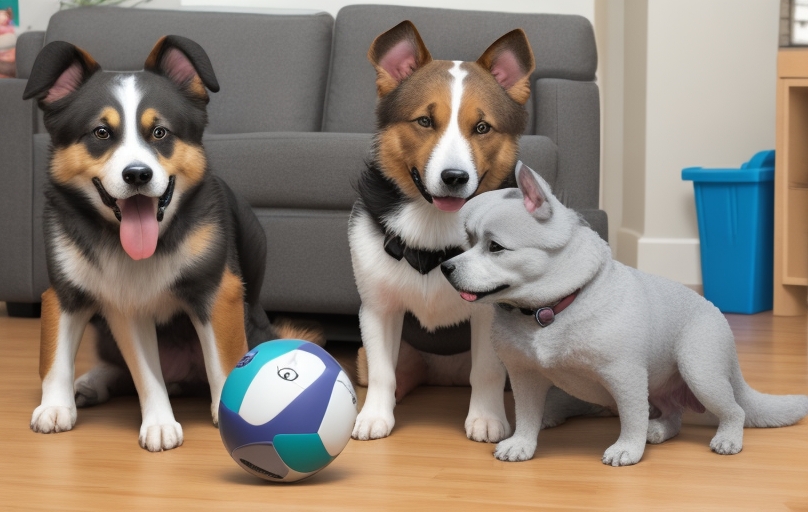How To Teach Two Dogs to Get Along? Introducing a new dog to your household or helping two existing dogs get along is a process that requires patience, consistency, and understanding. However, with proper guidance and training, most dogs can learn to coexist peacefully and become best friends. In this article, we will provide a detailed guide on how to teach two dogs to get along.
Scientific Research Studies
The Effects of Positive Reinforcement on the Social Behavior of Dogs in a Multi-Dog Household (2019)
This study found that positive reinforcement training was effective in reducing aggression and increasing positive interactions between dogs in a multi-dog household. The researchers used a variety of positive reinforcement techniques, such as treats, praise, and petting, to reward the dogs for positively interacting with each other.
The Effects of Play Therapy on the Socialization of Dogs (2017)
This study found that play therapy was effective in improving socialization and reducing aggression in dogs. Play therapy is a type of therapy that involves using play to help dogs learn how to interact with other dogs in a positive way. The researchers in this study used play therapy to help dogs who were poorly socialized or who had difficulty interacting with other dogs.
How To Teach Two Dogs to Get Along

Assess Their Personalities:
Before bringing a new dog into your home or addressing existing issues between two dogs, it’s important to assess their personalities. Dogs have unique temperaments, and their ability to get along with other dogs can vary greatly. Consider factors such as age, size, energy level, and past experiences with other dogs. For example, a calm, older dog may be more tolerant of a playful puppy than another active and dominant dog.
Gradual Introduction:
If you are introducing a new dog to your household, start with a gradual and controlled introduction. Choose a neutral location, such as a nearby park, to minimize territorial behavior. Keep both dogs on a leash and allow them to observe each other from a distance. Slowly decrease the distance between them over several sessions, always monitoring their body language. Look for signs of aggression or discomfort, such as growling, barking, raised hackles, or stiff body posture.
Positive Reinforcement:
When the dogs first meet and exhibit calm behavior, reward them with treats and praise. This positive reinforcement helps create positive associations with each other. Continue to use treats and praise when they display good behavior during subsequent interactions. If one dog is particularly anxious or aggressive, work with a professional dog trainer or behaviorist for guidance.
Supervised Playtime:

Once the initial introductions are successful, allow the dogs to interact under close supervision. It’s best to start with short play sessions and gradually increase their time together. Watch for play behavior like chasing, wrestling, and playful barking, which are all positive signs of getting along. However, always be prepared to step in if the play escalates into aggression.
Establish House Rules:
Consistency in house rules is crucial to maintaining harmony between your dogs. Make sure both dogs understand basic commands like “sit,” “stay,” and “leave it.” Reinforce these commands regularly and equally. Feeding time should also be structured – feed the dogs separately to prevent food-related aggression.
Separate Personal Spaces:
Dogs need their own personal space and safe zones. Provide each dog with their crate or a separate area where they can retreat when they need a break or some alone time. Respect their need for space and don’t force them to interact constantly.
Equal Attention and Affection:
It’s essential to give both dogs equal attention and affection. Jealousy can lead to conflicts, so ensure that neither dog feels neglected. This includes walks, playtime, and cuddles. Balanced attention reduces the likelihood of rivalry.
Training and Socialization:

Ongoing training and socialization are key to maintaining a harmonious relationship between two dogs. Enroll in obedience classes, engage in positive reinforcement training, and take them on outings to expose them to different environments and experiences.
Professional Help:
If your dogs continue to have issues getting along, or if their behavior escalates to aggression, seek help from a professional dog trainer or behaviorist. They can assess the situation and provide specific guidance and exercises tailored to your dogs’ needs.
Read Also: How to Help Dogs Get Along
Conclusion:
How To Teach Two Dogs to Get Along? Teaching two dogs to get along requires patience, consistency, and understanding. Assess their personalities, introduce them gradually, use positive reinforcement, and supervise their interactions. Establish house rules, provide personal spaces, and offer equal attention and affection. Ongoing training and socialization are essential for maintaining a peaceful coexistence. If problems persist, don’t hesitate to seek professional assistance. With time and effort, most dogs can learn to get along and become loyal companions to each other and to you.
FAQs
1. How long does it usually take for two dogs to get along?
The timeline for dogs to bond varies, but it can take anywhere from a few days to several months. It depends on their personalities, past experiences, and how well you manage their introduction.
2. What should I do if my dogs are showing signs of aggression?
If you notice signs of aggression, it’s crucial to separate them and consult with a professional dog trainer or behaviorist for guidance on resolving the issue.
3. Can two male dogs get along?
Yes, two male dogs can get along, but it may require extra attention to their introductions and interactions, as same-sex aggression can be more common.
4. Is it easier for two puppies to get along?
Yes, introducing two puppies tends to be easier as they are more adaptable and less set in their ways. Early socialization is key to their successful bonding.
5. How can I prevent jealousy between my dogs?
To prevent jealousy, ensure that both dogs receive equal attention, love, and care. Avoid favoritism and maintain consistent interactions with both pets.

1 thought on “How To Teach Two Dogs to Get Along? A Comprehensive Guide”